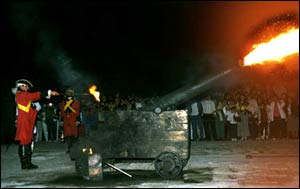A CANNON BALL FIRING AT NINE

By Luis Felipe Sexto
Don’t be frightened by the noise. It’s the sound of tradition. It was born, as a daily and monotonous military regulation, when the circle of stone and steel that protected the Villa de San Cristóbal de la Habana was finished. Each day at 4:30 in the morning and 8 at night, the opening and closing of the fortifications walls was announced with the cannon ball firing. This is how, every day, the city woke and slept, like a domesticated beast, to sound of a whip.
As time went by, the closing hour of the city was delayed for one hour. The lifting of the bridges, the lowering of the grilles and the blocking of the doors were all actions that announced the cannon ball firing. The Villa grew and its walls couldn’t contain it. Havana’s geography and its people developed. And the demolition of the walls began. There are still some ruins standing. The cannon ball firing at 9 o’clock was kept as the city’s practice and identity.
The fortress San Carlos de la Cabaña, considered unassailable and never attacked, is the scene of the cannon ball firing ceremony, carried out by soldiers dressed as in colonial times, with attending public. In the year 1762, the English seized Havana and after a dramatic resistance, forced the castle of Los tres reyes del Morro to surrender. In a bold act, the English took the hill where La Cabaña would later stand, and with that they were able to conquer the villa.
Later on, by way of a treaty, England gave Havana back to Spain and in 1763 the construction of the strategic fortress was started. It was ended 11 years later. The explosion at 21 hours shares its location in the fortress next to the office of Che Guevara’s Command Post during the revolutionary triumph in 1959, a weapons museum and a walled perimeter from which you can have an impressive view of the city.
Without interruption, the “cañonazo” is heard in all the corners of Havana. It can be heard at the Parque Central, at 4,3 seconds at the Nacional Hotel at 9,7, and at the historic corner of 23 and 12 at 16 seconds after the firing.
It was silenced only one once. In 1942, the dictator Fulgencio Batista gave the order to silence it “due to reasons of war and to save explosives”. In December, 1945 the legendary cañonazo again took place, letting us hear, at 9, history’s echo.
0 comentarios